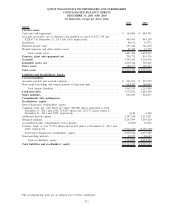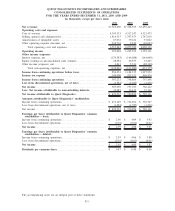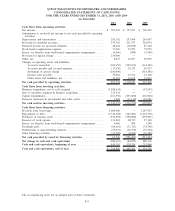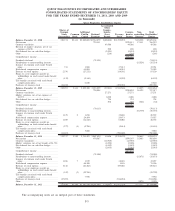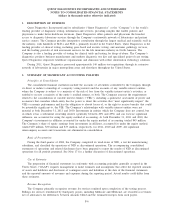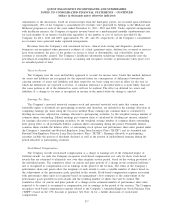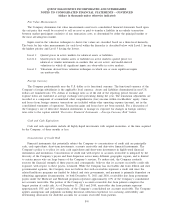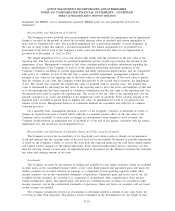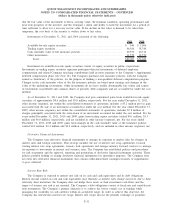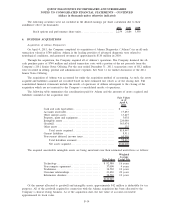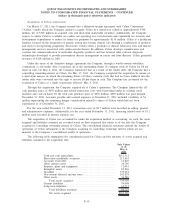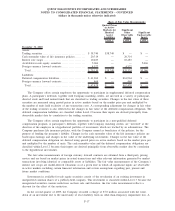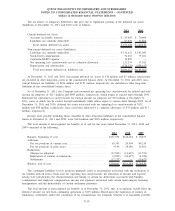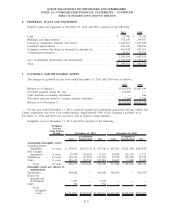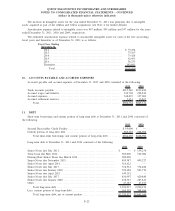Quest Diagnostics 2011 Annual Report Download - page 84
Download and view the complete annual report
Please find page 84 of the 2011 Quest Diagnostics annual report below. You can navigate through the pages in the report by either clicking on the pages listed below, or by using the keyword search tool below to find specific information within the annual report.without the exchange of underlying principal or notional amounts. Net settlements between the counterparties are
recognized as an adjustment to interest expense.
The Company accounts for its derivatives as either an asset or liability measured at its fair value. The fair
value is based upon quoted market prices obtained from third-party financial institutions and includes an
adjustment for the credit risk of the obligor’s non-performance. For a derivative instrument that has been formally
designated as a fair value hedge, fair value gains or losses on the derivative instrument are reported in earnings,
together with offsetting fair value gains or losses on the hedged item that are attributable to the risk being
hedged. For derivatives that have been formally designated as a cash flow hedge, the effective portion of changes
in the fair value of the derivatives is recorded in accumulated other comprehensive (loss) income and the
ineffective portion is recorded in earnings. Upon maturity or early termination of an effective interest rate swap
designated as a cash flow hedge, unrealized gains or losses are deferred in stockholders’ equity, as a component
of accumulated other comprehensive (loss) income, and are amortized as an adjustment to interest expense over
the period during which the hedged forecasted transaction affects earnings. At inception and quarterly thereafter,
the Company formally assesses whether the derivatives that are used in hedging transactions are highly effective
in offsetting changes in the fair value or cash flows of the hedged item. All components of each derivative
financial instrument’s gain or loss are included in the assessment of hedge effectiveness. If it is determined that a
derivative ceases to be a highly effective hedge, the Company discontinues hedge accounting and any deferred
gains or losses related to a discontinued cash flow hedge shall continue to be reported in accumulated other
comprehensive (loss) income, unless it is probable that the forecasted transaction will not occur. If it is probable
that the forecasted transaction will not occur by the originally specified time period, the Company discontinues
hedge accounting, and any deferred gains or losses reported in accumulated other comprehensive (loss) income
are classified into earnings immediately.
Foreign Currency Risk
The Company is exposed to market risk for changes in foreign exchange rates primarily under certain
intercompany receivables and payables. Foreign exchange forward contracts are used to mitigate the exposure of
the eventual net cash inflows or outflows resulting from these intercompany transactions. The objective is to
hedge a portion of the forecasted foreign currency risk over a rolling 12-month time horizon to mitigate the
eventual impacts of changes in foreign exchange rates on the cash flows of the intercompany transactions. The
Company does not designate these derivative instruments as hedges under current accounting standards unless the
benefits of doing so are material. The Company’s foreign exchange exposure is not material to the Company’s
consolidated financial condition or results of operations. The Company does not hedge its net investment in non-
U.S. subsidiaries because it views those investments as long-term in nature.
Comprehensive Income (Loss)
Comprehensive income (loss) encompasses all changes in stockholders’ equity (except those arising from
transactions with stockholders) and includes net income, net unrealized gains or losses on available-for-sale
securities, foreign currency translation adjustments and deferred gains and losses related to certain derivative
financial instruments (see Note 12). Total comprehensive income, including the amount attributable to
noncontrolling interests, was $487 million, $789 million and $813 million for the years ended December 31,
2011, 2010 and 2009, respectively.
New Accounting Standards
In May 2011, the Financial Accounting Standards Board (“FASB”) issued an amendment to the accounting
standards related to fair value measurements and disclosure requirements that result in a consistent definition of
fair value and common requirements for the measurement and disclosure of fair value between GAAP and
International Financial Reporting Standards. This standard provides certain amendments to the existing guidance
on the use and application of fair value measurements and maintains a definition of fair value that is based on
the notion of exit price. This standard will become effective for the Company on January 1, 2012 and is not
expected to have a material impact on the Company’s consolidated financial statements.
F-12
QUEST DIAGNOSTICS INCORPORATED AND SUBSIDIARIES
NOTES TO CONSOLIDATED FINANCIAL STATEMENTS - CONTINUED
(dollars in thousands unless otherwise indicated)


